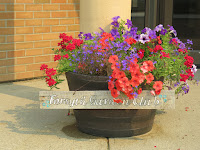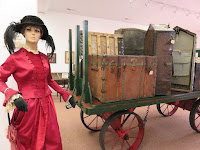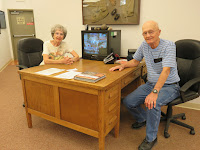The Blue Charley Chronicles has moved! Please visit the new site at The Blue Charley Chronicles – Roadside attractions, small towns, museums, and more from the USA
One-hundred miles east of Billings, Montana, lies the town
of Forsyth. With a population just under 2,000 people and a largely-decaying
city center, you’d miss it completely if you didn’t veer just slightly off of
Interstate 94 and follow the brown signs to the historical markers; luckily, I
did.
My tour of the town starts at the Rosebud County Museum.
There, a retired couple named James and Lavina Hall greet me and tell me about
the features of the museum.
Looking at a map of Montana, the shape of Rosebud County somewhat
resembles that of Vermont except it branches off more on the upper left than
upper right. Forsyth is located smack dab in the middle, and considering it
also has the county courthouse, it makes sense it’s the home of this museum.

One of the first things I am struck by is an entire miniature of the town as it looked in the late 40’s and early 50’s. Constructed by Forsyth High graduate Roy Pabolo, the miniatures are in exquisite detail, right down to the people, cars, and advertising on the store windows. Just about everything is gone now, but the courthouse, the high school, the Howdy Hotel, and the Roxy Theater still stand.


There’s an extensive library, with memories of the
townspeople forever preserved in booklets and albums. An 18-ton giant Avery
thirty horsepower steam engine, which lay buried in snow at the foot of a
mountain for 50 years before being rescued, shines proudly for generations to
come. There’s washers and shoe shine chairs; a one-room schoolhouse replica, a “country
kitchen,” and a 1900’s bedroom.




German prisoners-of-war were kept at Forsyth during World
War II, and an overcoat with the letters “P.W.” is scrawled on its back.
There are pictures and artifacts of the Native American people and culture alongside family portraits of locals; an album of Rosebud County Derby winners; railroad pamphlets and memorabilia from Forsyth’s Centennial festivities; and a little corner dedicated to world champion trick roper George Pitman.
Forsyth was founded by Thomas A. Alexander. He filed a
homestead in 1876, 16 years into the Homestead Act. In the business of selling
firewood to steamers, he traded part of his land to the Northern Pacific and in
1882 Forsyth became a division point for the railroad.
Town historian C.O. Marcyes noted that before the division
point “there was no occasion for a town. What little supplies that were
required by the hunters, Indian traders and trappers were either brought in by
long freight teams or by steamboats plying along the river.”
Indeed, dividing the town from the Interstate is a railroad
and station. Like many towns that once thrived on the railroads, and also those
on state highways who lost out to the Interstates, Forsyth has moved on from
its glory days – struggling to identify itself anew while at the same time
paying homage to its past.
“We used to have clothing stores,” says Lavina. “Now it’s
mostly casinos, bars, cafés…” she adds, her voice trailing off wistfully.
Lavina is a third generation Forsyth resident – her mother
and grandmother preceded her. It was always more of a ranching town than a
railroad town as she tells it, with the dominant production being sugar beets,
wheat, and cattle. She graduated from Forsyth High in 1955. The school’s
nickname is the Dogies (not doggies or a version of the canine – a dogie is a
motherless calf in cattle herd). But even as Forsyth is in some ways dropping
off the map, there are plenty of historical markers around town to remind you
of its past.
The Roxy, for example, debuted in 1930 and it was a real
beauty. “Equipped with RCA sound-producing equipment, the new theater boasted
red velour curtains, spring cushion seats, Spanish lanterns in the foyer, and
six small Spanish balconies in the auditorium itself,” reads the plaque.
Currently the Roxy is showing It.
The Merchant’s Bank Block has a colorful history. Built by
Alexander, it served as a bank and a post office in the early years. Legend has
it that Hiram Marcyes (father of C.O. Marcyes) blackballed Alexander from the
Masons, but Alexander incorporated a hall on the second floor for “the use of
secret societies” (i.e. other fraternal organizations). The building would
later feature a bowling alley tacked onto the rear, and a hotel among other
pursuits.
And the McCuiston Building once headlined as “Tourist’s
Headquarters” when the concept was still new. At the time, they were selling
Fords, Hudsons, and Franklins there. In 1916, a young man lit a match to check
the progress on an attendant filling up his gas tank; luckily the fire scarred
only the car and not the building or men.
One of the more interesting current buildings is the 2nd
Hand Store. It could easily be a hoarder’s home as a combination of thrift
store items and antiques are piled haphazardly everywhere, spilling into walkways
and rising high off floors and shelves.




Forsyth is a mix of old and new. Although “new” in this case refers to decaying or vacant storefronts, and a proliferation of those bars and casinos, the “old” includes beautiful murals painted on several walls (including that of the fire station); the courthouse and high school still being fixtures in the community (there are several “dogie” banners hanging around town); and a pot of flowers in front of the library, planted by The Garden Club (which has been around for up to a century, as archival photos attest).
Before exiting, I thank the curators and shake their hands.
I had heard them talking to what must have been their child or grandchild.
James served in the Navy. They seem like the very kind of people that makes a
small town one worth sticking around in, a community of comfort and
down-to-earth relationships. Thousands of tourists and Montana residents must zoom
past Forsyth every week. I can’t stop at every “historic town” that I encounter,
but I’m sure glad I stopped at this one.



























You must be the only person who has ever written about this tiny place! Nice job!
ReplyDelete